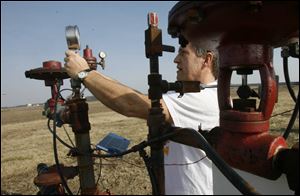
Change in law opens Ohioans way to be mini-moguls in natural gas
4/2/2006
Jim Hoops monitors Ohio Gas Co. wells in Fulton County, including one on his own land.
With natural gas three times more expensive than it was five years ago, many Ohio residents are seeking ways to get cheaper fuel.
Thanks to a state law passed in 2004, some are digging wells on their properties, selling the gas to utilities, and getting free gas in the deal.
It used to be that local communities had the ability to say, You must come to us to get a permit to put a well in. But the law changed and if you have a minimum of 20 acres nobody can stop you, said Jim Halloran, an energy analyst with National City Private Client Group in Cleveland.
Mr. Halloran and his neighbors in suburban Cleveland collectively are studying drilling for gas on their properties. If a well yields gas, they anticipate getting royalties from selling the gas, plus getting free gas for their homes.
In northwest Ohio, the fertile underground fields of natural gas and oil were tapped out by the 1930s, after delivering 500 million gallons of oil and 1 trillion cubic feet of natural gas.
As a result, the new law mainly benefits eastern and southeastern Ohio, where gas pockets are still plentiful.
In Fulton County, though, Yohe Enterprises, of Armada, Mich., has 12 productive gas wells and drilled three just south of Wauseon in December.
One well and a compressor operation that sends the gas to Ohio Gas Co. sit on Jim Hoops land. He maintains the wells for the owner, and he and 14 landowners split 10 percent of the profits from the wells. Unfortunately, he doesn t get free gas, and instead uses propane.
Originally free gas was talked about, he said. When we built a house back here in 1998, we built it so that we d be able to hook into the gas wells, but under the contract everything goes to Ohio Gas Co.
The wells are about 450 feet deep and although they are good producers, I don t think it s met the owners expectations, Mr. Hoops said.
The area is dotted with wells from the 1930s and 1940s, an indication that much has been tapped out, he said.
A handful of new wells have been dug since 2004 in Seneca, Wyandot, and Fulton counties. All were done by commercial companies at a cost of about $100,000 per well.
Norstar Petroleum Inc., of Centennial, Colo., owns the wells in Seneca and Wyandot Counties, which an executive said are close to starting production.
But some experts said that, at depths of 2,000 feet or so, northwest Ohio has potential new gas supplies. Such supplies are difficult to pinpoint, but may be available through new drilling techniques.
Northwest Ohio supplies originally were tapped by drillers heading straight down, and likely they withdrew 20 to 30 percent of the supply, said Rex Baker, president of Bakerwell Inc., a family-owned gas drilling and operating company in Killbuck, Ohio.
Horizontal drilling, more common today, can more easily tap nearby pockets when the drill route is turned 90 degrees underground, he said.
Still, he cautioned, more oil than gas likely remains in northwest Ohio.
The law that took effect in 2004 swept aside municipal restrictions that virtually eliminated urbanized gas wells, said Mike McCormac, a geologist with the Ohio Department of Natural Resources. It made drilling easier.
Since the law changed, 387 drilling permits have been issued, about three-fourths of them in urban areas.
We had no clue how much opportunity was really out there, Mr. McCormac said.
He expected 20 to 40 more permits a year.
In Cleveland and areas to the east, two dozen gas wells have been drilled on golf courses. Wells also are popping up on church properties, in subdivisions, and at private residences.
Geauga County had 12 gas wells drilled in 2003. In 2005, there were 49. Demand is so high in Ohio that drilling outfits have started waiting lists.
Currently, the state estimates 10,000 residents receive free natural gas from leases on their properties. An additional 4,000 residents own an active well or one that is no longer commercially viable but enough to supply a homeowner.
Unlike past community restrictions, the law states that any well up to 4,000 feet deep requires 20 acres; deeper wells require 40 acres.
The rules apply only to municipalities with populations of at least 5,000.
Mr. McCormac said the layer of most previous natural gas wells in northwest Ohio is dry, but several hundred feet below that is another layer that isn t consistent across north central and parts of northwest Ohio.
There hasn t been a lot of success finding it, he said.
Contact Jon Chavez at: jchavez@theblade.com or 419-724-6128.